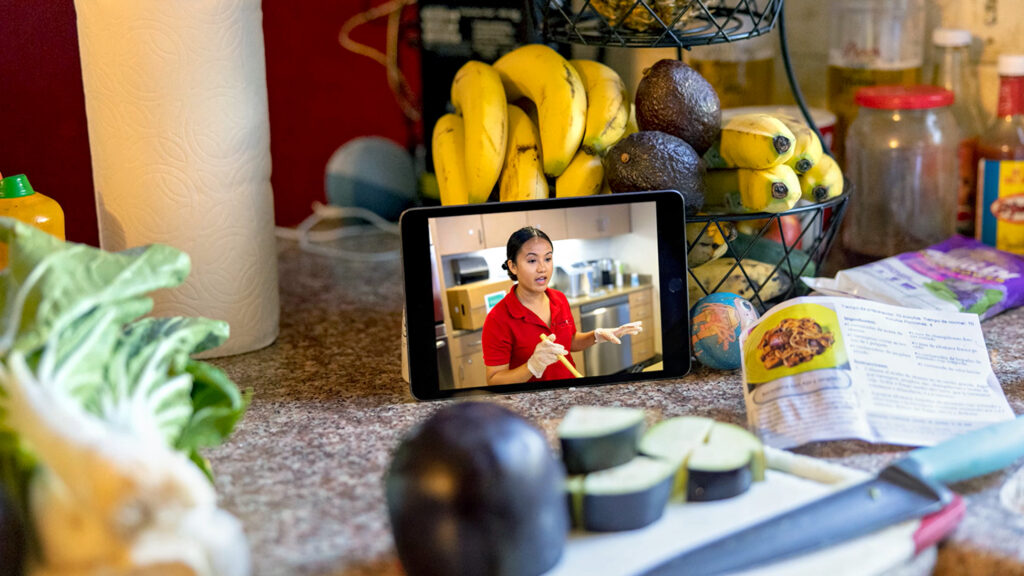
In Stockton, California, almost 60% of the city’s 320,000 residents are prediabetic or living with diabetes. Shane Bailey, a 72-year-old longtime resident and U.S. Coast Guard veteran, is one of them. And because she lives in a neighborhood that is considered a food desert because it lacks nearby grocery stores, it can be a huge challenge to access healthy, affordable food.
“I live in the Central Valley with a lot of produce being grown. But in Stockton, it’s often either very expensive, or low quality, or both,” said Bailey.
However, thanks to Abbott and the Public Health Institute’s Healthy Food Rx program, she’s had a boost in making the lifestyle changes that help her manage her condition. The program was a pilot study in which 374 patients with diabetes received biweekly healthy meal kits including fresh produce from Emergency Food Bank Stockton/San Joaquin for a year.
“It was fun to learn how to cook these healthy meals. It kept me busy and improved my mental health,” said Bailey. Each of the boxes came with recipes, and participants could join a virtual cooking class to learn how to make each meal. Her favorite meal was a green veggie stir-fry with chicken — packed with broccoli, kale, spinach, and bok choy — tossed in warm olive oil and Asian spices.
The Food Rx program was the subject of one of two recent studies, neither of which have yet been peer-reviewed, that show the benefits of produce prescription programs as a way to improve diabetes-related health outcomes and address food insecurity. Advocates say that programs that treat food as medicine could go a long way toward helping low-income people and people with chronic conditions, especially those who live in food deserts.
“Health disparities exist in communities of color — Latino and Black communities — and the people who live in these communities are most affected by diabetes because they tend to live in historically under-resourced neighborhoods,” said Maggie Wilkin, the director of research and evaluation at the Public Health Institute’s Center of Wellness and Nutrition and lead author of the poster presentation. Healthy food access is one important lever in addressing those disparities.
The findings of the Food Rx pilot study were presented Tuesday at the American Public Health Association annual meeting. Overall, participants’ hemoglobin A1c readings — which measure average blood sugar levels over three months — decreased significantly over the year, from 9.73% to 8.93%, among those whose readings were outside of target range at baseline. According to the Centers for Disease Control and Prevention, a hemoglobin A1c reading between 5.7% and 6.4% is considered prediabetic.
Researchers also found that food insecurity among participants decreased by 10%. In addition, participants reported making greater lifestyle changes to manage their diabetes, such as engaging in more physical activity, checking blood sugar daily, following diabetes meal plans, and going to diabetes education or nutrition classes.
Bailey, who’s on Medicare and receives VA health benefits, wished that the program lasted even longer. “I want to participate in more programs like this that are affordable and accessible,” she said.
Involving community organizations like food banks could offer a sustainable way to continue such programs in other cities or towns, according to Wilkin. She said that the study’s findings support policies providing reimbursable, medically-tailored meals for people with chronic conditions. “Organizations trying to implement produce prescription programs can apply for the U.S. Department of Agriculture’s Gus Schumacher Nutrition Incentive Program to receive funding,” she said.
Payers can cover food as medicine programs amid growing research that shows it leads to improved health outcomes, she told STAT.
Further south in California, in Los Angeles, Kaiser Permanente Southern California led a randomized control trial of a six-month produce prescription program among 450 patients on Medicaid.
Study participants were randomly assigned to three different groups: a control group, whose members did not receive free fresh produce, and higher- and lower-dose intervention groups that received free weekly produce deliveries. Produce amounts were scaled to meet the participant’s household size, and valued at a range from $90-270 for the higher-dose group and $90-180 for lower-dose households. All of the participants who got the free produce were also offered free diet and nutrition counseling sessions with registered dietitians or nutritionists by telephone.
The findings, which were presented at the American Heart Association’s scientific sessions earlier this week, showed that patients in both the high- and low-dose intervention groups improved their blood sugar levels, with an average A1c reduction of 0.32 points.
Additionally, the data showed a large improvement in food security and nutrition security status: the odds of being food secure increased by about 230% and the odds of being nutrition secure increased by 370% for patients in both the intervention groups compared to the control group.
“Obesity and diet-related illnesses, such as diabetes, are leading causes of morbidity and mortality and contribute to rising health care costs,” said lead author Claudia Nau, a research scientist at Kaiser Permanente Southern California department of research & evaluation. “We can provide medical care and dietary counseling, but when patients cannot afford to access healthy foods, they cannot follow advice on diet and nutrition.”
Earlier in 2023, the Centers for Medicare & Medicaid Services announced an opportunity for states to address health-related social needs for people with Medicaid coverage in managed care plans with “in lieu of” services, Nau notes. States can now offer alternative benefits that take aim at a range of unmet health-related social needs, such as providing nutritious, prepared meals and healthy groceries or vouchers to support enrollees’ health needs.
In the big picture, Wilkin said, programs like these are investments to inspire healthy habits in participants for years to come. “Giving people the tools and resources to try new foods and make new recipes will be sustained beyond the program and lead to better outcomes for people with diabetes long term,” she said.
Source: statnews.com






















Add comment